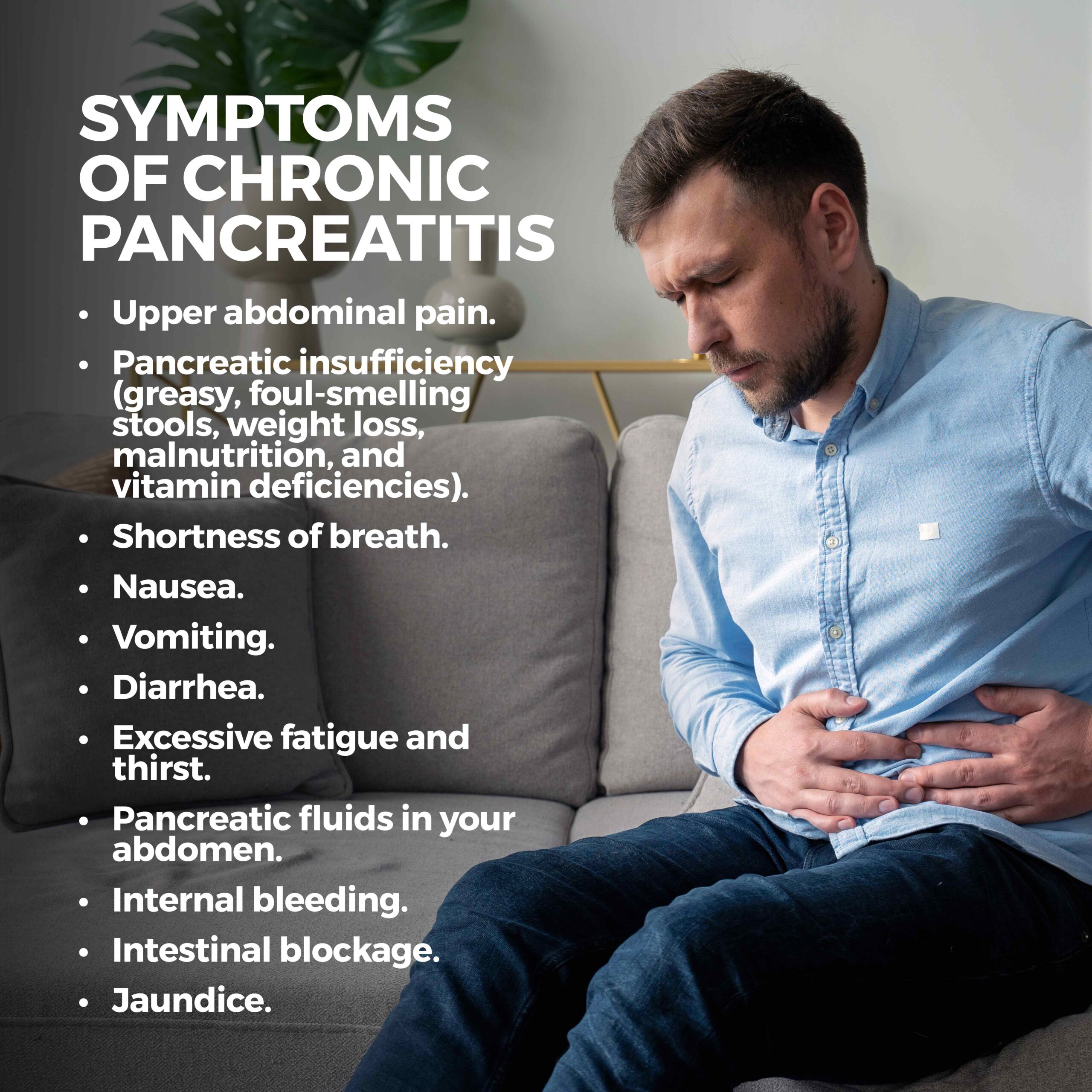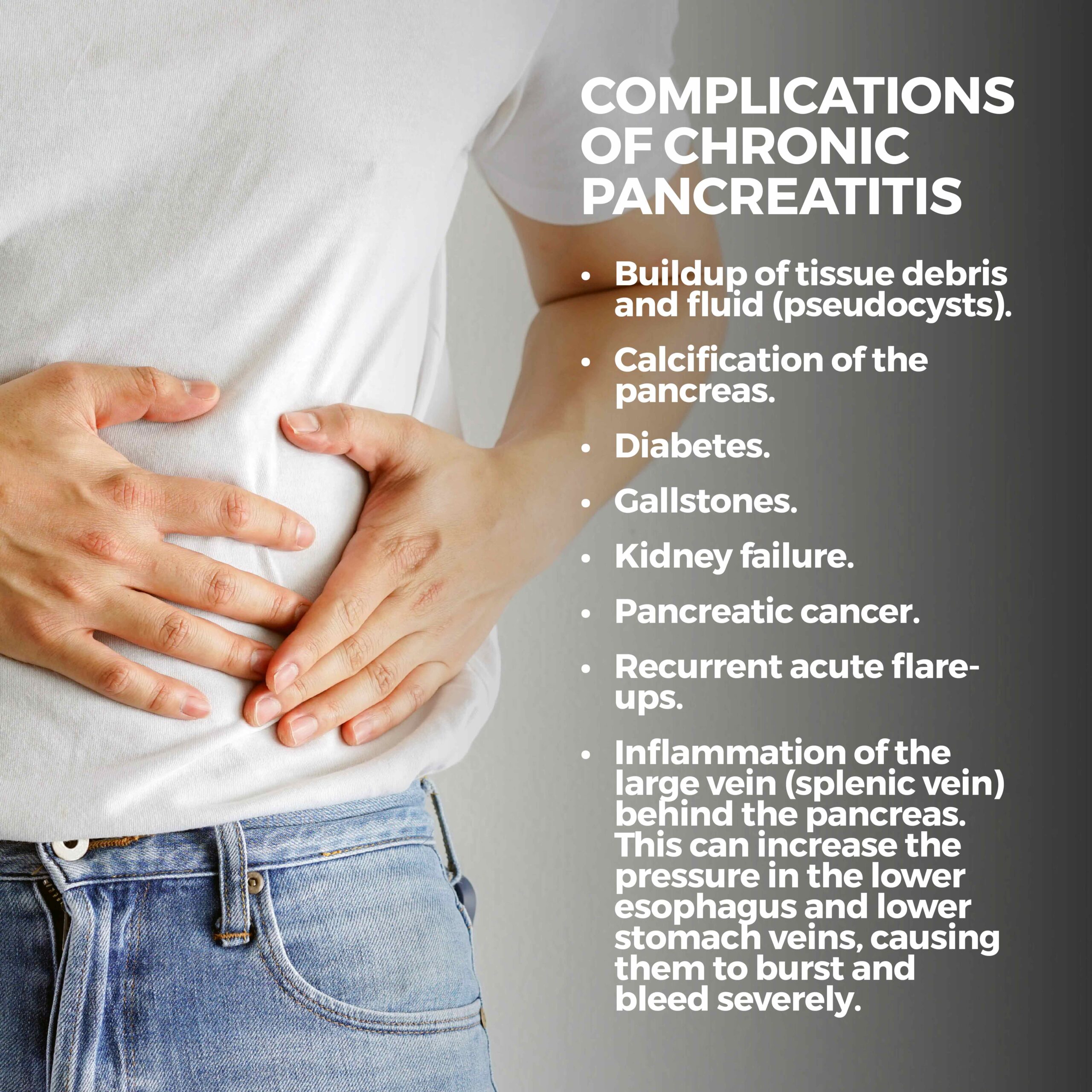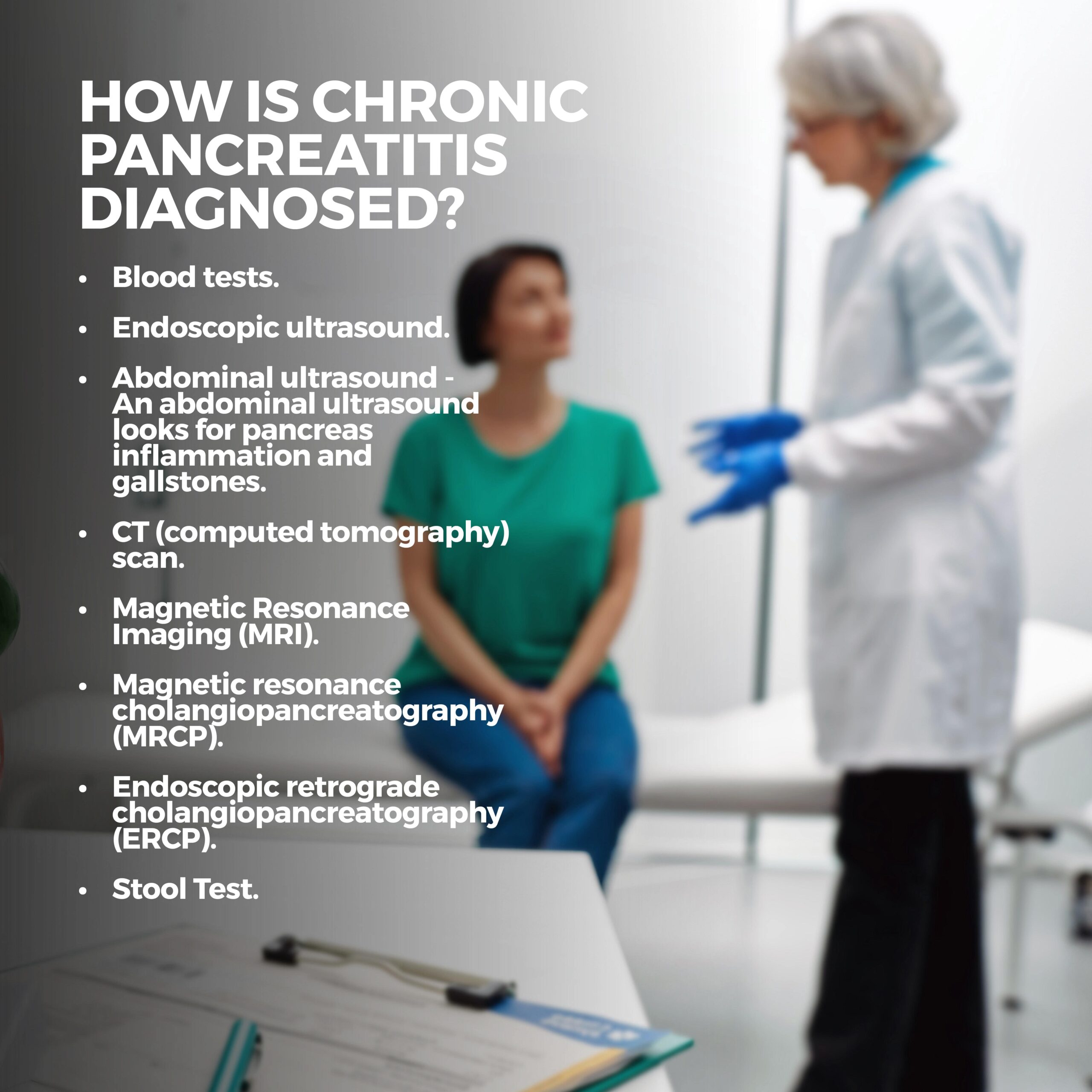
Chronic Pancreatitis
Chronic pancreatitis is a long-term inflammation of the pancreas. The pancreas is an organ located behind the stomach that makes digestive enzymes. It also produces a hormone called insulin that regulates your blood sugar levels. When you have chronic pancreatitis, digestive enzymes that usually flow through your pancreas’s tubes into your upper intestine get trapped in your pancreas. This can cause pain and scarring. Chronic pancreatitis leads to damage that gets worse over time and permanently destroys the pancreas.
How Common is Chronic Pancreatitis?
Chronic pancreatitis strikes about 200,000 Americans and more than one million people worldwide. It typically develops in people between 30 and 40 and affects more men than women. Chronic pancreatitis is rare in children, although it can be hereditary or caused by trauma to the pancreas. It may also be linked to cystic fibrosis in children.
What Causes Chronic Pancreatitis?
A healthy pancreas makes digestive enzymes that don’t become active until they enter the upper part of the digestive tract. But if you have chronic pancreatitis, these enzymes become active before they’re released and attack the tissues of the pancreas. As the tissues become damaged, they can’t produce new enzymes. Scar tissue develops, the pancreas shrinks, and it can no longer produce enough enzymes for proper digestion. It becomes irreversibly damaged.
The most common cause of chronic pancreatitis is heavy, long-term alcohol abuse. About 70% of chronic pancreatitis cases are related to alcoholism. Other causes include:
- Smoking.
- Calcium stones and cysts.
- Autoimmune disorders.
- Chronic renal failure (inability of kidneys to filter waste from the blood).
- Obesity.
- Gallstones.
- Abdominal injury.
- Diabetes.
- Genetic defects.
- Certain medications.
Acute pancreatitis can lead to chronic pancreatitis. Acute pancreatitis is a short-term inflammation, but repeated attacks can damage the pancreas and lead to a chronic condition.
What Are the Symptoms of Chronic Pancreatitis?
Upper abdominal pain is the main symptom of chronic pancreatitis. The pain’s intensity may fluctuate, and flare-ups may last hours or days. As the illness progresses, pain may become incessant. The pain usually worsens after eating or drinking.
Another notable symptom of chronic pancreatitis is pancreatic insufficiency. When you have pancreatic insufficiency, the number of digestive enzymes in your pancreatic fluid decreases. When this happens, food isn’t adequately broken down or properly absorbed. This results in greasy, foul-smelling stools. This malabsorption of food can also trigger weight loss, malnutrition, and vitamin deficiencies.
Other chronic pancreatitis symptoms include:
- Shortness of breath.
- Nausea.
- Vomiting.
- Diarrhea.
- Excessive fatigue and thirst.
As the disease worsens, you may experience the following:
- Pancreatic fluids in your abdomen.
- Internal bleeding.
- Intestinal blockage.
- Jaundice.

What Are the Complications of Chronic Pancreatitis?
Chronic pancreatitis destroys the pancreas’ insulin-producing cells and may cause complications, including:
- Buildup of tissue debris and fluid (pseudocysts).
- Calcification of the pancreas. This happens when pancreatic tissue hardens from calcium salt deposits.
- Diabetes.
- Gallstones.
- Kidney failure.
- Pancreatic cancer.
- Recurrent acute flare-ups.
- Inflammation of the large vein (splenic vein) behind the pancreas. This can increase the pressure in the lower esophagus and lower stomach veins, causing them to burst and bleed severely.

How is Chronic Pancreatitis Diagnosed?
First, your doctor will examine your abdomen. They’ll also ask whether there is a family history of pancreatic disease or cystic fibrosis and about your drinking habits. After this, your doctor may order one or more of these tests:
- Blood tests – These tests can determine whether you have elevated levels of pancreatic enzymes. They can also analyze liver enzymes, white blood cells, kidney function, and detect high glucose levels.
- Endoscopic ultrasound – An endoscopic ultrasound creates detailed images of your gallbladder and pancreas to show inflammation or blockages.
- Abdominal ultrasound – An abdominal ultrasound looks for pancreas inflammation and gallstones.
- CT (computed tomography) scan – A CT scan uses X-rays and a computer to create three-dimensional images of your pancreas. It looks for gallstones and determines the seriousness of pancreas inflammation.
- Magnetic Resonance Imaging (MRI) – An MRI looks for defects in the pancreas, gallbladder, and ducts.
- Magnetic resonance cholangiopancreatography (MRCP) – MRCP uses a magnet, radio waves, and a computer to create images of your pancreas and gallbladder ducts. A dye may be injected to create more detailed images.
- Endoscopic retrograde cholangiopancreatography (ERCP) – This procedure uses an endoscope and X-rays to diagnose inflammation and blockages in pancreatic and bile ducts.
- Stool test – This test measures levels of fat that could show your digestive tract isn’t effectively absorbing nutrients.
Sometimes, no cause for pancreatitis is discovered. This is called idiopathic pancreatitis.

How is Chronic Pancreatitis Treated?
Daily treatment of chronic pancreatitis may include pancreatic enzyme supplements, steroids, medicine, and other treatment options.
Steroids are given to people with chronic pancreatitis caused by immune system problems. It helps reduce inflammation. But taking steroid medication for a long time can cause weight gain and osteoporosis.
First-line treatment for chronic pancreatitis pain is mild anti-inflammatory medications such as Advil or Motrin (ibuprofen) and Tylenol (acetaminophen). If these don’t provide relief, you may need to take opioids such as codeine or tramadol. You may also be given gabapentin, amitriptyline or pregabalin. A nerve block may be given to curb pain for several weeks or months. This interferes with the nerves that send pain signals to your pancreas.
Insulin could be an option if you develop diabetes, and some people take vitamin supplements.
Surgery
If your pain doesn’t go away, surgery may be necessary. These procedures include:
- Endoscopic surgery. Endoscopic surgery with lithotripsy may provide relief if you have gallstones at the opening of your pancreas (pancreatic duct). During lithotripsy, shock waves break the stones into small pieces. Then an endoscope removes these pieces. Endoscopic surgery may also be done to drain cysts, unblock your pancreatic duct or widen it if it’s too narrow.
- Pancreas resection. If parts of your pancreas have severe pain and inflammation, they can be surgically removed with pancreas resection. This procedure may also be performed if endoscopic treatment has failed.
- Total pancreatectomy. If your pancreas is highly damaged, it may have to be removed entirely. Although this procedure is effective for treating pain, your body will no longer be able to produce insulin. To counteract this, autologous pancreatic islet cell transplantation (APICT) may be performed. During this procedure, the cells that produce insulin (islet cells) are removed before the surgical removal of your pancreas. Then they’re mixed with a special solution and injected into your liver. These cells stay in your liver and begin to produce insulin. Although this may be effective in the short term, you may still need additional insulin therapy in the future.
What to Eat if You Have Chronic Pancreatitis
The best foods you can eat if you have chronic pancreatitis include:
- Fruits.
- Vegetables.
- Whole grains.
- Legumes.
- Lean meat.
- Low-fat or nonfat dairy, almond milk.
- Healthy fats (avocado, olive oil, fatty fish).
Be sure to drink plenty of water or electrolyte drinks.
The worst foods you can eat include:
- Alcohol.
- Fried foods.
- Fast food.
- Refined carbohydrates.
- Red meat.
- Chocolate.
- Processed cheese.
- Cakes, cookies, and pastries.
- Potato chips.
- Margarine and butter.
- Anything containing caffeine.
These foods can make your pancreas release too many enzymes at once, triggering a flare-up.
Eat five to six small meals daily instead of three big ones, and stay hydrated. Your doctor may refer you to a dietician to help you adjust your eating habits.
Other Checks
If you have chronic pancreatitis, you should get the following:
- Annual checkups to make sure your diet is providing adequate nutrition.
- A diabetes blood test every six months.
- A bone density check every two years.
- An annual check for pancreatic cancer (if your chronic pancreatitis is hereditary).

Contact Us
At GastroMD, we’re committed to partnering with you to find and implement the best possible treatment and management plan for your chronic pancreatitis. Call us today! The team of professionals at GastroMD looks forward to working with you. We are one of the leading gastroenterology practices in the Tampa Bay area. We perform a host of diagnostic procedures using state-of-the-art equipment in a friendly, comfortable, and inviting atmosphere where patient care is always a top priority.



